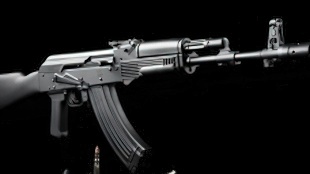您需要 登录 才可以下载或查看,没有账号?注册

x
Surgery Room – Environment Breakdown – Gilad Baruch 手术室 – 环境分解 – 吉拉德·巴鲁克

Hi, I am Gilad Baruch , an Environment Art student from Israel. Currently, I’m studying environment art at ThinkTankOnline. Before this project and my study at Think Tank, I was freelancing as a 3D generalist mostly for archviz and small indie projects. 嗨,我是吉拉德·巴鲁克,来自以色列的环境艺术学生。目前,我正在ThinkTankOnline学习环境艺术。 在这个项目和我在智库学习之前,我是一名3D通才的自由职业者,主要负责建筑可视化和小型独立项目。
After a while, I decided to change my direction to environment art so I signed up to ThinkTank. In this article, I’ll break down my intermediate-term final project. 过了一会儿,我决定改变我对环境艺术的方向,所以我报名参加了ThinkTank。在本文中,我将分解我的中期最终项目。
Reference gathering 参考资料收集
When I was asked to choose a concept for the project all I knew is that I want to make an abandoned place with a scary mood. After a lot of searching, I found Dr. Anna’s house location which was just perfect for this kind of project. 当我被要求为这个项目选择一个概念时,我只知道我想做一个带有可怕情绪的废弃地方。经过大量的搜索,我找到了安娜博士的房子位置,非常适合这种项目。
This location was very well documented by photographers and had a lot of photos and videos from different angles of the room which helped me a lot. After finding the photos I created a PureRef file containing most of them. 这个位置被摄影师记录得很好,有很多来自房间不同角度的照片和视频,这对我帮助很大。找到照片后,我创建了一个包含其中大部分照片的PureRef文件。
Blockout and modeling 遮挡和建模
To set up the room dimensions I had to figure out a scale reference from the image so I can estimate the room dimensions. I estimated the wall tiles were 16x16cm. After that, I started to block out the walls. Then I blocked out the main assets, exported them to Unreal and made a first lighting pass 为了设置房间尺寸,我必须从图像中找出一个比例参考,以便我可以估计房间尺寸。我估计墙砖是16x16厘米。 在那之后,我开始堵住墙壁。然后,我屏蔽了主要资源,将它们导出到虚幻引擎,并进行了第一次光照。
After blocking out the scene I made sure the dimensions of the door is playable and wont cause any problems with collisions and such. I also made sure all the modular assets works well and were ready to be used in the engine. assets For most of the small assets, I didn’t have time the make a proper high poly bake so I used one segment bevels with harden normal to fake the high poly look. In my opinion this is a great way to save time for smaller assets when you’re in a rush. HardenNormals The add-ons I used to boost my workflow in Blender are – , , and . I really recommend checking them out. I did not use any ready models in the scene besides the ivy which is from Mega scans. 在屏蔽了场景之后,我确保门的尺寸是可玩的,并且不会引起任何碰撞等问题。我还确保所有模块化资产都能正常工作,并准备好在引擎中使用。 资产 对于大多数小型资产,我没有时间进行适当的高多边形烘焙,因此我使用了一个具有硬化法线的段斜面来伪造高多边形外观。在我看来,当您赶时间时,这是为较小资产节省时间的好方法。 哈登常态 是。我真的建议看看他们。 除了来自Mega扫描的常春藤之外,我没有在场景中使用任何现成的模型。 Texturing To create the tiling textures I used Substance Designer. In Designer, I used a lot of techniques including photos and importing sculpted mesh to Designer from ZBrush. I also created some base materials in Designer to be later used in substance painter. To achieve a more realistic and unique look, I created a damaged and clean version for the tileables to mix them later using vertex painting. Plaster-scaled Tiles-scaled To texture the unique props I used substance painter. I noticed that the scene had a lot of rusty assets so I created a smart rust material using anchor points with blurs and slope blurs which came out pretty nice. 纹理 为了创建平铺纹理,我使用了物质设计器。 在 Designer 中,我使用了很多技术,包括照片和从 ZBrush 向 Designer 导入雕刻网格。 我还在Designer中创建了一些基础材料,以便以后用于实质绘画。 为了实现更逼真和独特的外观,我为可拼贴创建了一个损坏且干净的版本,以便以后使用顶点绘画将它们混合在一起。 石膏鳞片 磁贴缩放 为了纹理独特的道具,我使用了物质画家。我注意到场景中有很多生锈的资产,所以我使用带有模糊和斜坡模糊的锚点创建了一个智能生锈材料,结果非常好。 RustPainting Shaders After the texturing was done it was time to set up the shaders for the scene. I created a few master materials and I also created some materials functions to integrate into the master materials. I also used static switch parameters to keep the shader optimized. MasterMat I created a Dust function that allows to quickly apply procedural dust effect around the scene. This helped me a lot in achieving the dusty look of the scene around the modular assets. I recommend checking this if you want to make a dust material in Unreal. I also created a simple vertex painting function and a dirt function. This is where the damaged textures that I made earlier take place. I used detail textures and masks to combine microtextures with macro textures. This workflow helped me to achieve high texel density while adding some unique features to the asset. Here’s a great explaining more about detail normals. DetailNormalOnOff After assigning the textures and creating the shaders it was time for a decal pass. For the edge damage decal, I created an SD graph that generates a damaged decal from an alpha input. SDEdgeDecal SDTrashDecal I also created some dirt, leaks, and gradient decals to achieve the dirty looks of the scene. Some of the dirt alphas are from megascans, but most of them made by me. 着色 纹理完成后,是时候为场景设置着色器了。 我创建了一些主材质,还创建了一些材质函数以集成到主材质中。我还使用了静态开关参数来保持着色器的优化。 MasterMat 我创建了一个"灰尘"函数,该功能允许在场景周围快速应用程序化灰尘效果。这对我实现模块化资产周围场景的尘土飞扬的外观有很大帮助。 如果你想在虚幻引擎中制作灰尘材质,我建议你查看这个。 我还创建了一个简单的顶点绘制函数和一个污垢函数。这就是我之前制作的损坏纹理发生的地方。 我使用细节纹理和蒙版将微观纹理与宏观纹理相结合。此工作流帮助我实现了高纹素密度,同时为资产添加了一些独特的功能。这是一个很棒的,解释了更多关于细节法线的信息。 详细信息正常关闭 在分配纹理并创建着色器之后,是时候进行贴花通道了。 对于边缘损坏贴花,我创建了一个 SD 图,该图形从 alpha 输入生成损坏贴花。 SDEdgeDecal SDTrashDecal 我还创建了一些污垢,泄漏和渐变贴花,以实现场景的肮脏外观。 一些污垢阿尔法来自巨型扫描,但其中大部分是由我制造的。 decal1 Lighting For the lighting I started by placing a directional light, then I placed an HDRI sphere and a SkyLight actor. I also placed some spotlights and rect lights around the scene to light up some dark spots I wanted to show more. Then I added an exponential height fog with volumetric fog in order to add the light shaft and some mood to the scene. To create the light shaft I Placed a movable spotlight with very high volumetric value to create the effect. This helped me a lot in setting up the lighting. To bake the lighting I used the GPU Lightmass which is INSANE! The baking times were very short and provided very high-quality bakes that allowed me to change and tweak the lighting without previewing it on low quality. This helped me a lot with troubleshooting and understanding the GPU lightmass. Here are my final settings for the GPU lightmass. I found these settings to provide the best result for my scene, but these settings would probably be different based on your scene. 照明 对于照明,我首先放置了一个定向光源,然后放置了一个HDRI球体和一个SkyLight演员。我还在场景周围放置了一些聚光灯和矩形灯,以照亮一些我想展示更多的黑点。 然后,我添加了带有体积雾的指数高度雾,以便为场景添加光轴和一些情绪。 为了创建光轴,我放置了一个具有非常高体积值的可移动聚光灯来创建效果。这个在设置照明方面对我帮助很大。 为了烘烤照明,我使用了GPU Lightmass,这是疯狂的!烘焙时间非常短,提供了非常高质量的烘焙,使我能够更改和调整照明,而无需以低质量预览。 此在故障排除和了解 GPU 灯质量方面对我有很大帮助。 以下是我对 GPU 光量的最终设置。我发现这些设置为我的场景提供了最佳效果,但这些设置可能会因场景而异。 Conclusion This project was my first environment in unreal and it was very challenging to complete in such a short amount of time. This whole project took about one and a half months. I’m very happy with how this project came out and how I progressed during this term. My advice for an aspiring artist who wants to create such a scene is to focus on the bigger and more important detail of the scene and try not to get stuck and waste time on small details that won’t be visible or far from the camera. I’d just like to thank my term supervisor Sergei Panin who provided me with a lot of knowledge and help during this project and term. 结论 这个项目是我第一个在虚幻环境中完成的项目,在这么短的时间内完成这个项目是非常具有挑战性的。整个项目花了大约一个半月的时间。我对这个项目的出现以及我在这个学期的进展感到非常满意。 对于想要创建这样一个场景的有抱负的艺术家,我的建议是专注于场景中更大,更重要的细节,并尽量不要卡住并浪费时间在看不见或远离相机的小细节上。 我只想感谢我的任期主管谢尔盖·帕宁(Sergei Panin),他在这个项目和任期内为我提供了很多知识和帮助。
| 














